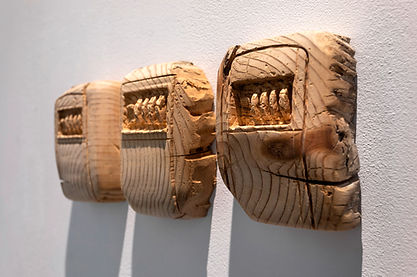Clara Diab & Mads Christoffersen
RIDING THE BLUE WAVE
An exhibition on flow and undertow
August 8th - 18th 2025
exhibition opening: Friday, August 8th at 8PM
"There is nothing more uncertain or more unsound than putting all your eggs in one basket. Tourism alone cannot support the principality for a number of obvious reasons, the first being that this industry is highly variable, and therefore very fragile," said Prince Rainier III of Monaco back in the 1940s. [1]
Today, 80 years later, we live in a country that has indeed put “all its eggs in one basket,” and with each passing tourist season, we witness the same things: price inflation, traffic collapse, and the “exodus” of the local population. As citizens of a country where tourism accounts for 25% of GDP, one of the highest shares in Europe, we are complicit in giving everything to tourism, even the most precious thing like our own home - it is known that many leave their homes in the summer, all in the eternal ambition and need to make a seasonal profit from them.
Leaving home also leads to leaving the city itself, so sometimes a local gathering place is transformed into a tourist center of nightlife. The need to earn money from tourism is not surprising, considering that life for a local person throughout the year, and especially in the season, is extremely challenging. The basic and necessary things, such as groceries or rent, are becoming more and more unattainable every day. Yet precisely what makes it unattainable is the very same thing in which the ordinary person seeks salvation – [mass] tourism.
This burning issue has not escaped the attention of the artistic duo Clara Diab and Mads Christoffersen. During their residency at Prostor, they conducted research largely based on conversations with locals of different backgrounds and ages, aiming to hear and feel the reality of seasonal everyday life. Throughout their research journey of the realities of Split and Croatia, they noticed similarities with the book 24/7: Late Capitalism and the Ends of Sleep by Jonathan Crary, which thus became the building block of the project.
Crary is referring to an actual plan from the late 1990s when a Russian-European space company was founded to launch satellites equipped with ultra-thin mirrors capable of reflecting sunlight back to Earth. The goal was to enable 24-hour industry and resource exploitation in parts of Siberia and western Russia. Later, the company proposed using such mirrors to illuminate urban areas under the slogan “daylight all night.”
Presented by the work Seven Wonders, the artistic duo install the same absurd mirror structures on the Chinese wall/Kineski zid building, which would transform it into the first 24/7 summer resort in Split. That way, visitors arriving on cheap late-night flights could immediately slip into their swimsuits and begin the process of getting the desired sun-kissed tan. It is a dystopia in which artists contemplate what tourism could look like in the near future, in which the number of tourists grows to the point that they "tour" even at night.
The photo series titled Night Shift explores that exact scenario, where two tourists sunbathe, relax with a picnic and read the morning newspaper—at night, all under a constant beam of light that follows them. Such a chaotic future - reflected in the collage Storm in Spinut - is completely opposite to the past that a neighbor, Mrs. J, took the duo through - a past when foreigners stayed for weeks in the homes of Croatian families, building friendships and living everyday life among the locals.
Today, visitors book anonymous vacation flats, which, just like here in the gallery space, often have key safes, the use of which does not even require getting to know the landlord. These safes, carved from discarded wood from the nearby Art Nouveau Villa Jaman, are embodied in the work Ghost Town. The act of discarding and abandoning the wood of a once-majestic villa draws a parallel — will the apartments in the Chinese Wall/Kineski zid face the same fate, once again in the name of airbnb-ization?
The present–future is one where tourists, like vast blue waves, wash over the city—bringing with them, as waves do, instability and constant change. Alongside the annual fortune-telling: "How will this tourist season turn out?", or how many waves will we encounter, the only choice left is whether we will calmly ride the waves, or be repeatedly hit by them—until, eventually, we capsize.
- Željka Ivančić
_____
[1] Jadrešić, Vlatko. Economic Contradictions and Negative Phenomena of Contemporary Tourism. Papers on Philosophy, Psychology, Sociology and Pedagogy 39.16 (2000): p. 264
Clara Diab (Malmo, Sweden, 1998) is educated at the Academy of Fine Arts in Umea, and at the Danish Royal Academy of Fine Arts. As an artist and poet, she works with power, climate and culture through sculpture, installation and performance. Often starting from a place’s history and contemporary conflicts, Diab uses spatial and economic limitations to her advantage. Over time, her style has become simpler yet retains a high level of details. In addition to creating and participating in various exhibitions, broadcasting radio and writing poetry collections, Clara produces props for TV.
Mads Christoffersen (Odense, Denmark, 1998) is educated from Umeå School of Architecture and The Bartlett, UCL, in London. His works engage with the existing built environment, intellectual history and future dystopias. Apart from his architectural work, Mads is involved in The Green Youth Movement (DGUB) where he is advocating for a complete construction ban.
From 2023, Diab and Christoffersen had a close collaboration. Their duo focuses on protecting modern cultural heritage by promoting local engagement.












